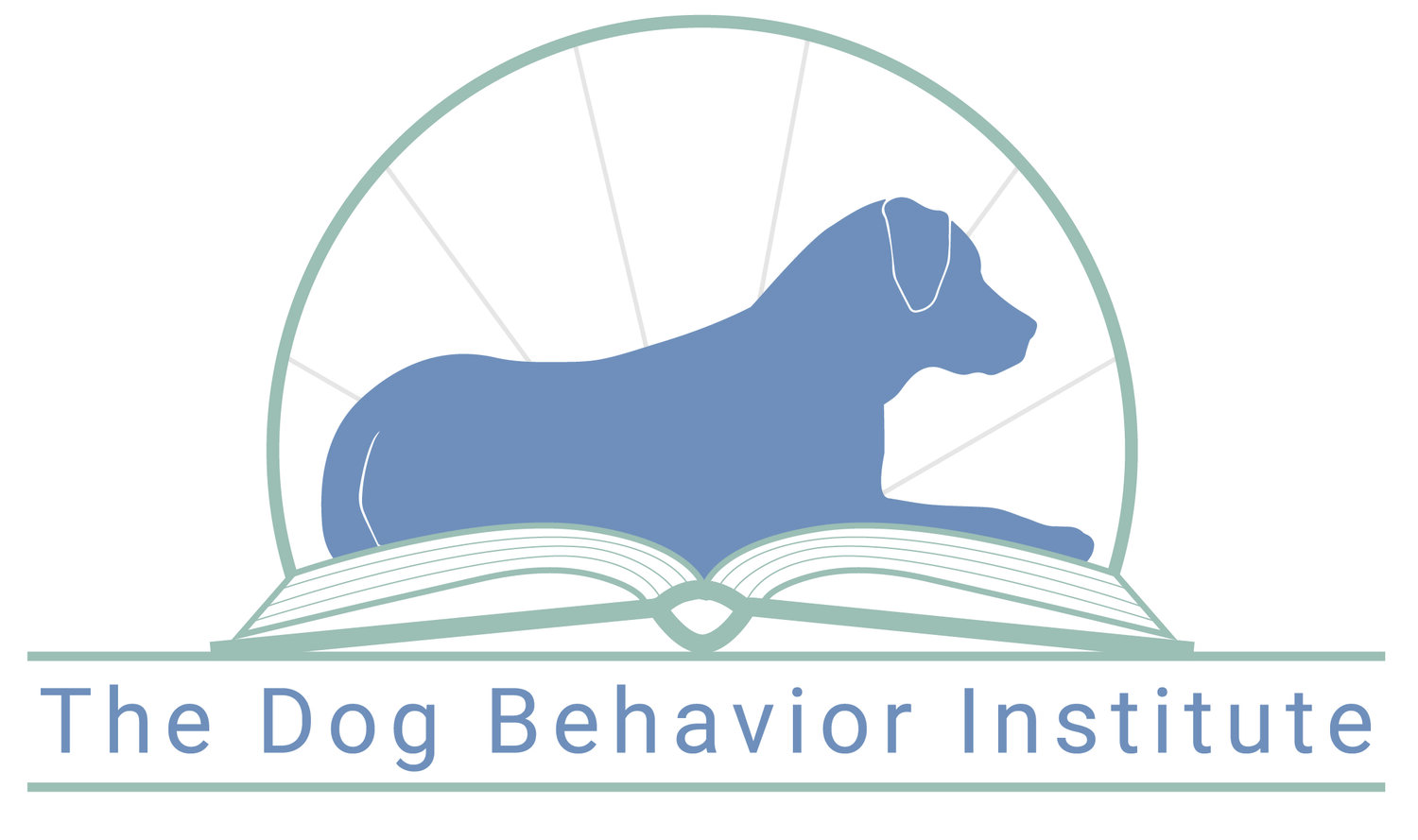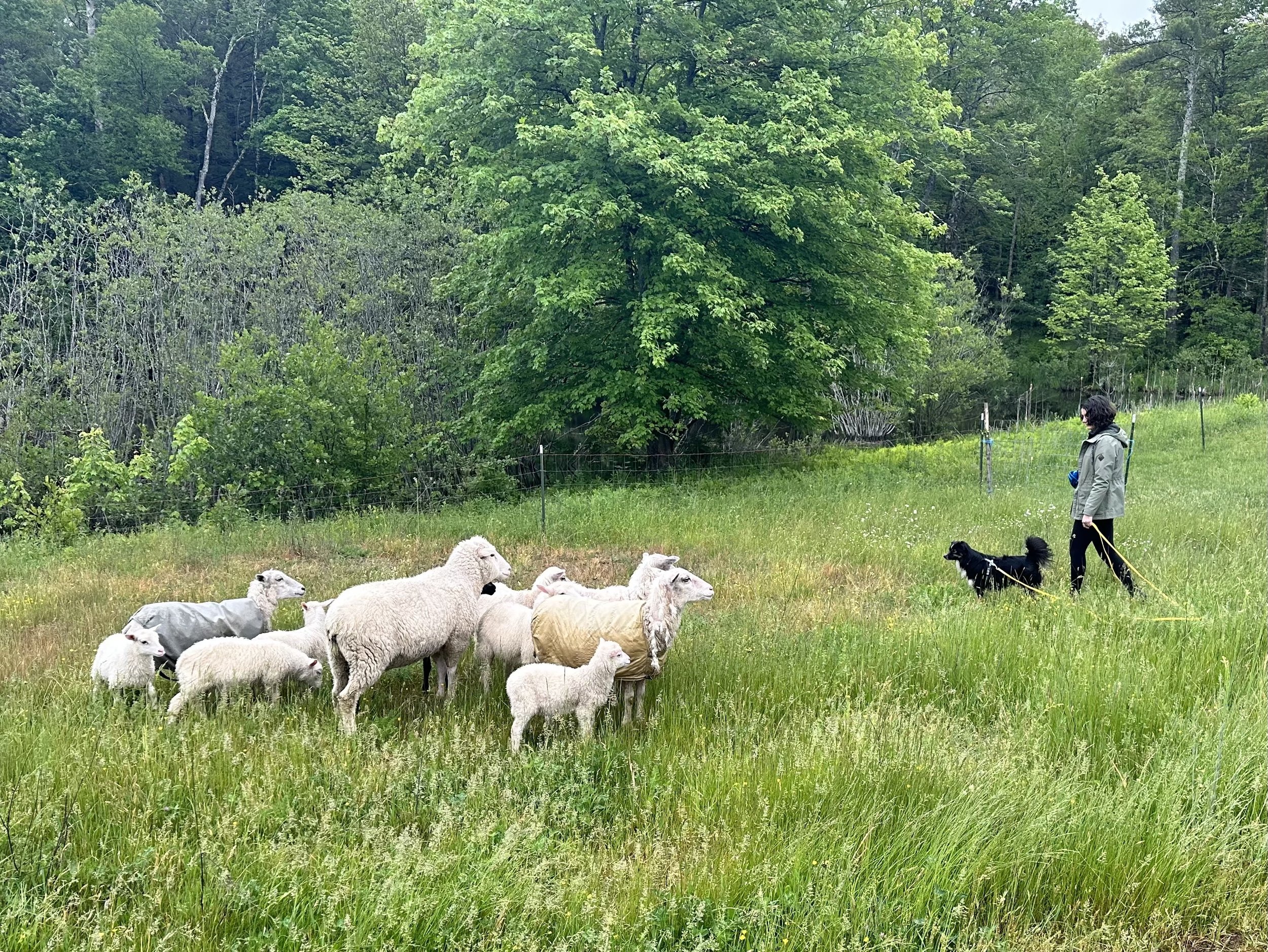Kerby the herding dog: In which we meet some sheep
By Stephanie Keesey-Phelan, Ph.D., BCBA
Kerby’s first introduction to sheep
If you’ve been following along on the blog, you’ll know that I have been exploring the fascinating world of herding with Kerby, my 2.5 year old mini Australian shepherd. After a few weeks of visits to our local farm I began to reach out to colleagues and search for locations to expose Kerby to stock. I also began to read Barbara Buchmayer’s Positive Herding 101: Dog-friendly training, the only book I could find that truly took a positive reinforcement-based approach to teaching a dog the skills for herding.
Kerby and I had been back to our local farm on a weekly basis to visit with the cows, goats, sheep, and pigs, and Kerby had successful and positive visits each time. I observed him orient toward the livestock at different points in time, and so far not emitting any stress-related responses that I could observe and he followed known cues within inches of the fenceline. I was thrilled with how much he seemed to enjoy these visits and his progress: how comfortable he seemed to be (few if any stress responses) and how with each visit I could give more known cues that he followed readily. But I had this itchy question in the back of my mind: did he have instinct for herding?
So… what is instinct?
I’m going to take a moment to pause here for a deep dive into the term “instinct.” What does it mean? Why does it matter for herding? Does it even matter for herding? Is it true that, as one sheepdog trainer told me, “most Aussie’s don’t have strong instincts to begin with”? I had been getting mixed messages about instinct since I started exploring herding. For some trainers, instinct was essential and a dog without it would never measure up as a herding dog. For others, dogs without instinct could herd, but it would be a lot more work on the handler’s part to direct the dog as it moved in relation to the sheep. Most of the sheepdog training farms I reached out to offered something called an “herding instinct test.” There are a few organizations that have a specific structure for herding instinct tests; in the United States, these include the American Herding Breed Association and the American Kennel Club, among others. However, some trainers will have their own, unofficial ways of conducting instinct tests. In general, the goal seems to be to assess whether or not the dog, typically in a small arena with a few sheep, will move the stock around the arena and respond to known cues such as stopping and recalling away from the sheep. The test may include more or less detailed evaluation of the ways in which the dog moves relative to the sheep and responds to cues given from the handler. All of this in service of determining whether or not the dog has instinct.
As a behavior analyst, when I’m learning something new I almost always start with definitions. It would be a challenge to determine if Kerby had instinct if I didn’t know what I was looking for. Additionally, I would want multiple people to observe Kerby’s behavior and come to some agreement (also known as interobserver agreement, or IOA) about whether or not he has said instinct. In this case I decided to start from the beginning, with the dictionary. Now please don’t groan when I start my next sentence with “The Oxford Languages dictionary defines…”. We have to start somewhere and the book whose job it is to give us definitions seems like a reasonable starting point to build from. So… The Oxford Languages dictionary defines instinct as “an innate, typically fixed pattern of behavior in animals in response to certain stimuli.” I have to say I was impressed; this is a much more technical definition than I thought we would be starting off with.
If I were to translate this definition into behavior analytic language I might break it down in the following ways:
Innate: this means we are talking about unconditioned (i.e., unlearned) respondent behaviors or reflexes. These are behaviors that are elicited by specific stimuli and not necessarily sensitive to the consequences that follow them.
Fixed patterns of behavior: This is an ethological term that refers to a sequence of innate (e.g., unlearned) behavior that is performed in a fixed, stereotypical manner across all members of a species. They are also elicited by a particular stimulus and not impacted by the consequences that follow them.
In animals: dogs in our case
In response to certain stimuli: The behavior occurs when certain stimuli are present, when thinking about sheepherding, presumably those stimuli would be the sheep
Putting this all together, we’re talking about a series of behaviors that a dog might engage in that are elicited by the presence and/or movement of a flock of animals, in Kerby’s case: sheep. I’ll pause here briefly to say that although we are specifically talking about reflexive behaviors that “just happen” when sheep are present, it does not mean that the consequences of those behaviors are irrelevant. Operant and respondent behaviors are always interacting - but this is a topic for another day and another post!
My visits to our local farm left me feeling pretty confident that Kerby wasn’t afraid of sheep or other farm animals. I wasn’t sure about whether or not he had instinct, and I also wasn’t sure if it even mattered whether I knew the answer to that question at this stage. I didn’t feel terribly comfortable pursuing a herding instinct test. The people I knew who offered them were the same ones who told me that positive herding wasn’t possible and that the dog needed to be corrected. I didn’t want to put Kerby in a situation like that, and I didn’t want his first actual interaction with sheep to be potentially aversive.
Kerby meets some sheep!
What I opted to do instead was to visit the farm of a behavior analyst friend who had sheep. My plan was for Kerby to spend lots of time around the sheep (read: on the other side of a fence), watch my friend’s seasoned border collie do some herding, and maybe, maybe if Kerby was doing well, I’d let him meet sheep while on a long line and without a barrier in place.
The drizzly day arrived and, as with other farms we’ve visited, Kerby was absolutely delighted to be there. I am not exaggerating when I say that I have seen some of Kerby’s most joyful behaviors while on a farm, and my friend’s farm was no different. Kerby’s bounces were bigger, his tail wags were looser. He bounded around from pasture to pasture, rolling in gross stuff, and soliciting play from her dog. On top of all that, he recalled when I cued it, engaged in all of his Control Unleashed games, and sat and lay down when cued. Kerby watched (with interest?) when the other dog worked the sheep and chimed in a bark here or there. My friend was confident that her sheep would not be needlessly stressed by Kerby’s presence or interaction with them and Kerby was doing great. I made the decision to let Kerby interact with the sheep within the pasture.
I took him into a large pasture with five ewes and six lambs. He was wearing a harness attached to a 15 foot biothane long line. I had my treats and a firm grip on the end of the long line. In total we spent about 5-7 minutes in the paddock - and for me it was a blur. If you asked me if Kerby had instinct for herding (as opposed to just chasing sheep; or ignoring them all together), I would not be able to answer you. However, I was fortunate that my friend observed and took some short videos and photos that I could analyze later on (note - this is ALWAYS a good idea if it can be done safely. You can miss so much in the moment!).
In looking at the video later, I watched as Kerby and I approached the sheep from the front. Kerby barked at them and looked back at me. It looked to me like he was trying to figure out how to get them to move. And then he did the thing - the instinct thing! (I shared the video with two other people with positive herding experience who agreed.) He trotted parallel to them and around behind the herd where he paused for a moment, barked, and began to trot and then run toward them. The sheep responded by trotting away and Kerby (and I, still holding onto the long line) followed along behind them. I continued on behind Kerby and allowed him to move toward and around the sheep. Kerby disengaged from the sheep, moving toward the fence line once or twice and though I did not actually record how long we were in the pasture, I approximate that it was less than 5-7 minutes.
What did I learn?
I kept the exposure short and controlled and was glad that I did because it had a specific purpose - to answer a question - and it met that purpose. Kerby might have some instinct for herding, but that doesn’t mean he has the skills or the experience to interact with sheep in this way safely, and I certainly don’t either! This is why I hung onto the long-line the entire time and did not let him get close enough to make contact with the sheep (though he didn’t try to).
While I was validated that my mini Aussie did, in fact, show some instinct for herding, this didn’t actually add anything to my training plan for Kerby. In the grand scheme of things, that means that this exercise simply satisfied my curiosity and provided Kerby a positive first exposure to sheep. Fortunately this interaction did not seem to stress out the sheep to any great extent (more on the ethics of herding in a later post - not to worry! I’ve been asked about this - and have been thinking about it - quite a bit).
While I had been getting Kerby out to farms, I was also reading and interacting with a few colleagues who know a lot more about herding and sheep than I do. The approach that they advocated for provided a roadmap, and that roadmap did not, at this stage, require any interaction with sheep. The plan going forward is one that is so consistent with everything we do in behavior analysis and R+ training; it involves breaking down and teaching the component herding skills away from livestock, teaching them to fluency, fading out props, and then gradually increasing the presence of the stock until we are ready to do some real herding. So although Kerby had a good experience and I learned about how he might interact with sheep in the future, knowing what I know now, I wouldn’t do this again at this stage in training.
What’s next?
Stay tuned! Next up I began my home training program and had the absolutely fantastic experience of attending a herding clinic in New York. I look forward to detailing these experiences in upcoming blog posts.
Have you missed prior posts? You can click on the links below to go back and read about the steps that led to this point in our journey.


